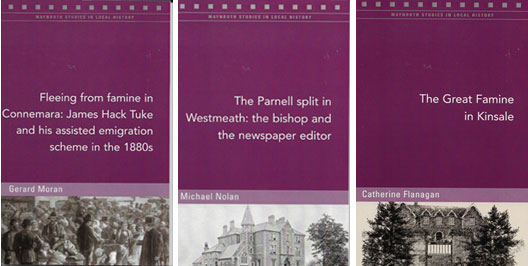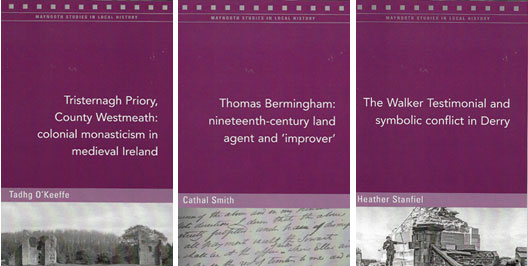BOOKWORM
Published in Book Reviews, Issue 6 (November/December 2018), Reviews, Volume 26By Joe Culley
At the height of the Famine, an English Quaker and philanthropist, James Hack Tuke, visited Connemara to assist the stricken populace and witnessed its full horrors. So when similar conditions threatened the region 30 years later, Tuke again mobilised his resources to help avert a catastrophe. His story is told in Gerard Moran’s Fleeing from famine in Connemara: James Hack Tuke and his assisted emigration scheme in the 1880s, part of the latest tranche from the Maynooth Studies in Local History series, edited by Raymond Gillespie.


Connemara was the only region of the country that saw its population increase after the Famine, largely because subsistence farming continued and smallholdings further subdivided, and the populace remained over-reliant on the potato crop. In 1878–9 it was the familiar story: congestion, poverty, famine and eviction. By 1880 Tuke believed that simple material aid would bring only short-term relief, and that a large exodus from the region would allow those who remained to prosper. This was at the height of the Land War, and many, like Parnell and Davitt, opposed his scheme. So, too, did many of the Catholic clergy. The people, however, had no qualms: they wanted out, and many begged to be put on Tuke’s list of those approved to travel.
Tuke believed that it was best to send entire families, as they would be more likely to prosper in their new home and it would free up their land for distribution. To qualify, a family had to have a few members over twelve who could work, and at least one who spoke English. Despite all the obstacles the scheme faced, in the early 1880s almost 5,000 people, or 12% of the region’s population, set sail for a new life in the US and Canada, in particular Philadelphia and St Paul. This, in turn, led to chain migration to those cities. Tuke, and his thinking, went on to play a significant role in the establishment of the Congested Districts Board.
At this same time, 1882, but halfway across the country, a young man from Roscommon, John P. Hayden, slipped across the county border into Mullingar to establish the Westmeath Examiner—and almost immediately he came into conflict with the bishop of Meath, Dr Thomas Nulty. Their story is told in Michael Nolan’s entertaining The Parnell split in Westmeath: the bishop and the newspaper editor, another of the new Maynooth releases from Four Courts.
Initially the pair clashed over plans to supply water to the town, but things quickly escalated over the Parnell crisis. The bishop, naturally, took against the IPP leader, while the young, modern Hayden sided with the Chief. Ultimately, Nolan argues, it was a struggle between the Church and a section of the young Catholic middle class for control of the nationalist movement, which was reflected countrywide. (Incidentally, Archbishop Croke described those who attended Parnell rallies as ‘corner boys, blackguards of every hue, discontented labourers, lazy and drunken artisans, aspiring politicians, Fenians, and in a word all irreligious and anticlerical scoundrels in the country’.)
Nulty banned the faithful from reading Hayden’s journal, while the editor wasted no opportunity to attack his clerical opponents. At one stage Hayden was jailed for attempting to block an eviction. Ultimately, of course, the bishop prevailed, but after his death Hayden went on to play a significant role in parliamentary politics. In the right hands this tale would make a great film.
The other releases in the Maynooth series include Catherine Flanagan on The Great Famine in Kinsale, Tadhg O’Keeffe’s study of Tristernagh Priory, County Westmeath: colonial monasticism in medieval Ireland and Cathal Smith’s work on Thomas Bermingham: nineteenth-century Irish land agent and ‘improver’, while Heather Stanfiel examines The Walker Testimonial and symbolic conflict in Derry.

The latest from the astonishingly prolific Father Thomas J. Morrissey SJ is The life and times of Daniel Murray: esteemed archbishop of Dublin 1823–1852. As the dates indicate, Murray held one of the most important positions within the hierarchy during one of the most turbulent periods of church/state relations. Remarkably, however, there has been relatively little study of the man. This may well be because he managed to draw the ire not only of his fellow Irishmen but also of Rome and his fellow bishops. He seems to have been a man who preferred compromise to confrontation. Thus nationalists considered him too close to the government when it came to Repeal, while the hierarchy thought the same on the question of Catholic education.
Indeed, education was one of Murray’s prime concerns, and led to the founding of the Irish Sisters of Charity and the invitation to Dublin of the Sisters of Mercy and the Irish Christian Brothers. He also supported the schools of the Jesuit, Vincentian and Loreto orders, and yet he championed the ‘godless’ Queen’s colleges. Father Morrissey clearly is fond of his subject, and his clear prose makes this an easy read. It will no doubt prompt further study of a significant figure.
The ‘biography of a year’ has been a genre for a while now, e.g. Turtle Bunbury’s 1847, or Bill Bryson’s One summer: America 1927. Now Kevin C. Kearns, known for his Dublin histories, has produced Ireland 1963: a year of marvels, mysteries, merriment and misfortune. As the title suggests, there was a lot more going on than the visit of JFK.
It began with an unprecedented blizzard—pre-climate change. There was a prolonged bus strike, a tenement collapse on Fenian Street and a sensational trial of a Roscommon woman accused of poisoning her farmer brother. Two UCD students died while hiking the snowbound Wicklow Mountains, and—in an echo of our times—Dublin Corporation’s ‘new brides’ house draw’ ended. In addition, of course, there was the gruesome murder of Hazel Mullen by her South African boyfriend, Shan Mohangi, in the Green Tureen restaurant. A nice gift for the Dub in your life.
The latest, chock-full edition of the Donegal Annual includes articles on amateur drama in the 1950s, the AOH in the revolutionary period, a libel trial related to an atrocity in Belfast in 1922, and the crosses and pillar stones of Inishowen.
Gerard Moran, Fleeing from famine in Connemara: James Hack Tuke and his assisted emigration scheme in the 1880s (Four Courts Press, €8.95 pb, 64pp, ISBN 9781846827211).
Michael Nolan, The Parnell split in Westmeath: the bishop and the newspaper editor (Four Courts Press, €8.95 pb, 64pp, ISBN 9781846827198).
Catherine Flanagan, The Great Famine in Kinsale (Four Courts Press, €8.95 pb, 64pp, ISBN 9781846827235).
Tadhg O’Keeffe, Tristernagh Priory, County Westmeath: colonial monasticism in medieval Ireland (Four Courts Press, €8.95 pb, 64pp, ISBN 9781846827181).
Cathal Smith, Thomas Bermingham: nineteenth-century Irish land agent and ‘improver’ (Four Courts Press, €8.95 pb, 64pp, ISBN 9781846827204).
Heather Stanfiel, The Walker Testimonial and symbolic conflict in Derry (Four Courts Press, €8.95 pb, 64pp, ISBN 9781846827228).
Thomas J. Morrissey SJ, The life and times of Daniel Murray: esteemed archbishop of Dublin 1823–1852 (Messenger Publications, €29.95 hb, 336pp, ISBN 9781910248935).
Kevin C. Kearns, Ireland 1963: a year of marvels, mysteries, merriment and misfortune (Gill Books, €16.99 hb, 384pp, ISBN 9780717180783).
Seán Beattie (ed.), Donegal Annual: Blianiris Dhún na nGall (Donegal Historical Society, €25 pb, 148pp, ISSN 04162773).
















